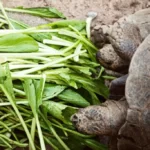Few culinary delights can compare to the satisfying crunch of fresh water chestnuts. These delightful, aquatic tubers not only add a unique texture to a wide range of dishes but also provide a wealth of health benefits. The best part? You can cultivate them right in your own garden or water garden. In this guide, we’ll embark on a journey into the world of growing water chestnuts, equipping you with the knowledge and skills to cultivate this tasty and versatile crop at home.
Imagine the convenience of having a steady supply of these crisp delicacies, free from the uncertainties of store-bought options. Whether you’re an experienced gardener or a beginner with a green thumb, growing water chestnuts can be a rewarding and satisfying endeavor. So, let’s dive in and explore the steps to cultivating your very own water chestnuts.
- 5pcs Water Chestnut Fruit Seeds
- Growth depends on soil and weather conditions.
- Item Package Quantity:1,No.of Seeds:50
Water Chestnuts
Before you embark on your water chestnut-growing adventure, it’s essential to understand the plant itself. Water chestnuts, scientifically known as Eleocharis dulcis, are not the nuts of a tree, as the name might suggest. Rather, they are aquatic tubers originating from a sedge plant that thrives in waterlogged conditions.
Water chestnut plants consist of underwater tubers attached to long, slender, grass-like stems. The tubers are the edible part of the plant, and they develop beneath the surface of the water. What sets water chestnuts apart is their crisp, crunchy texture and mild, slightly sweet flavor. They are a staple in various Asian and international cuisines, often used in salads, stir-fries, and appetizers. It’s essential to distinguish between Chinese water chestnuts and the European variety, as they differ in growth requirements and culinary uses.
Choosing a Planting Site
Selecting an appropriate planting site for water chestnuts is a critical first step in ensuring a successful crop. Water chestnuts are well-suited to aquatic environments and require specific conditions for optimal growth. Here are some factors to consider when choosing the right location:
- Water Depth: Water chestnuts thrive in shallow waters, ideally around 4 to 6 inches deep. This depth allows the plants to receive sufficient sunlight while maintaining steady moisture levels.
- Soil Type: The soil at the bottom of your water garden or container should be mucky or silty to provide the necessary nutrients for water chestnut growth. Loamy soil with good organic matter content is also suitable.
- Sunlight: Water chestnuts are sun-loving plants. Ensure that the planting site receives at least six hours of direct sunlight daily. Adequate sunlight is essential for photosynthesis and the development of tubers.
- Container vs. In-Ground: You can choose to grow water chestnuts either in an in-ground water garden or in containers. Each has its advantages, and your choice may depend on available space and water depth.
Carefully selecting the planting site is crucial to creating the ideal conditions for your water chestnut crop. Once you have chosen the right location, you’ll be well on your way to cultivating these crunchy delights in your own garden.
Planting Water Chestnuts
Once you’ve selected the ideal location for your water chestnut bed, it’s time to move on to the exciting process of planting. Here’s a step-by-step guide on how to plant water chestnuts:
Step 1: Acquire Water Chestnut Corms or Seeds
- Water chestnuts can be grown from corms or seeds. Corms are the more common choice as they lead to faster growth and require less maintenance. You can purchase corms from gardening stores or online sources.
Step 2: Prepare the Planting Area
- Whether you’re using an in-ground water garden or containers, ensure the soil or substrate is well-prepared. For in-ground beds, prepare the mucky or silty soil at the chosen location. If using containers, select suitable containers or tubs.
Step 3: Plant the Corms
- If planting in containers, fill them with the prepared substrate. For in-ground beds, simply plant the corms directly into the muddy soil.
- Place the corms about 3 to 4 inches apart and 2 to 3 inches deep in the substrate.
- Ensure the corms are placed with the growing points facing up. This orientation allows the tubers to develop more effectively.
Step 4: Maintain the Water Level
- Maintain a water depth of 4 to 6 inches throughout the growing season. This ensures the tubers remain submerged and receive enough sunlight.
Step 5: Provide Adequate Sunlight
- Water chestnuts are sun-loving plants. Ensure they receive at least six hours of direct sunlight each day for healthy growth.
Care and Maintenance
Cultivating water chestnuts doesn’t require an overly complex maintenance routine, but there are key considerations to ensure a successful harvest:
Water Management:
Monitor and maintain consistent water levels to keep the tubers submerged. Adequate moisture is crucial for tuber development.
Weeding:
Regularly inspect your water chestnut bed for unwanted plants and weeds. Removing them will prevent competition for nutrients and resources.
Fertilization:
Water chestnuts usually don’t require additional fertilization. However, if your water is nutrient-deficient, you can consider using aquatic plant fertilizer tabs.
Pest and Disease Management:
Water chestnuts are relatively pest-resistant. However, you should be vigilant for aphids and other common garden pests. Address any infestations promptly.
Harvesting:
Know when your water chestnuts are ready for harvest, typically around 120-140 days after planting. The corms will be ready to harvest when the stems turn brown and the tubers have reached an adequate size.
By following these care and maintenance guidelines, you can ensure the health and productivity of your water chestnut crop. With a little effort and attention, you’ll be rewarded with a bountiful harvest of crisp, homegrown water chestnuts to enjoy in your culinary creations.
Harvesting Water Chestnuts
Harvesting your homegrown water chestnuts is a moment of reward for all your efforts in nurturing these delightful tubers. Here’s how to know when and how to harvest:
Determining the Right Time:
- Water chestnuts are typically ready for harvest around 120 to 140 days after planting. You’ll notice that the stems of the water chestnut plant have turned brown, signaling that it’s time for harvesting.
Harvesting Process:
- Carefully dig up the tubers from the soil or substrate using your hands or a small gardening fork. Be gentle to avoid damaging the delicate tubers.
- As you unearth the corms, brush off the excess mud. Rinse them thoroughly to remove any remaining soil.
Post-Harvest Handling:
- Once harvested, store your water chestnuts in a cool and dark place or in the refrigerator to preserve their freshness. They can stay fresh for several weeks when stored properly.
Culinary Uses and Benefits
Now that you have your freshly harvested water chestnuts, it’s time to explore the culinary delights they offer:
Versatile Crunchiness:
Water chestnuts add a delightful crunch to various dishes, making them a favorite in stir-fries, salads, and Asian cuisine. They can be used both raw and cooked, adding a unique texture to your meals.
Nutritional Value:
Water chestnuts are not only delicious but also nutritious. They are low in calories and fat, making them an excellent choice for healthy eating. They are a good source of dietary fiber, potassium, and various vitamins and minerals.
Digestive Health:
The dietary fiber in water chestnuts promotes digestive health and can help prevent constipation. They also support a feeling of fullness, aiding in weight management.
Skin Health:
Water chestnuts contain antioxidants like vitamin C, which can contribute to healthier skin by combating oxidative stress and promoting collagen production.
Conclusion
Cultivating water chestnuts at home can be an enriching and rewarding experience. With a little effort and the right environment, you can enjoy a steady supply of these versatile and crunchy delights right from your own garden or water garden.
From understanding the unique growth requirements of water chestnuts to selecting the right planting site and caring for your crop, this comprehensive guide has equipped you with the knowledge and skills to successfully grow this remarkable root vegetable.
As you savor the crisp texture and mild sweetness of your homegrown water chestnuts in a variety of culinary dishes, you’ll not only delight in their deliciousness but also reap the nutritional benefits they offer. Whether it’s adding them to stir-fries, salads, or simply enjoying their crispness as a snack, water chestnuts are a versatile and healthy addition to your diet.
So, whether you’re a seasoned gardener or a novice with a passion for homegrown produce, consider embarking on the journey of growing water chestnuts. It’s an opportunity to connect with your food at a deeper level, from seed to harvest, and relish the pleasures of fresh, crunchy, and homegrown water chestnuts.




